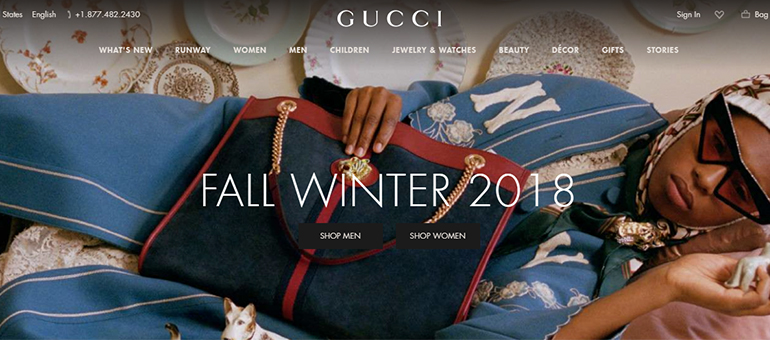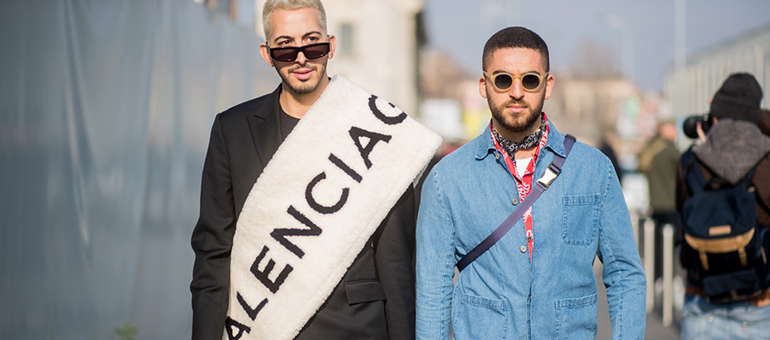
Digital
Michael Kors, Ralph Lauren Own Greatest Share of Luxury Online Traffic
by
Sarah Jones | September 18, 2018
Five brands accounted for approximately two-thirds of the total 186 million visits to luxury Web sites in the past year from the United States, according to new data from PMX Agency.
Luxury brands are taking creative risks and evolving, whether through unexpected creative director appointments or collaborations. These strategies are paying off in digital as Web site traffic is up 16 percent from 2017 and social media followers have grown 20 percent year-over-year.
Traffic Trends
Per PMX, Michael Kors, Ralph Lauren, Louis Vuitton, Coach and Gucci hold the most share of luxury online traffic, remaining unchanged from 2017.
The study found that Gucci’s site visits were up 72 percent in the last 12 months, propelled by continuing changes driven by artistic director Alessandro Michele. Gucci saw the greatest rise in traffic for the second year running.

Image: Gucci
Louis Vuitton achieved the second greatest bump in traffic, growing 37 percent in part due to the appointment of Virgil Abloh as its new artistic director of menswear.
Reflective of millennials’ growing importance in the luxury market, they now represent the generation with the greatest share of online traffic, with 20.2 percent of all site visits coming from those aged 25 to 34.
Men are also becoming a greater audience for luxury brands online, with their visits to high-end Web sites growing 10 percent year-over-year. PMX attributes this to the growing interest in streetwear among young men.
A prime example of this trend is Balenciaga, for whom the share of male visitors to its site has risen from 42 percent last year to 50 percent this year.

Image: HOLA
Luxury consumers are more mobile than the average shopper, with the portion of mobile views of luxury sites at 54 percent compared to 47 percent for the overall online population. Giuseppe Zanotti has the greatest portion of its traffic come through mobile, with 72 percent of its visits via mobile devices.
About half of luxury brand traffic comes from search, with Google driving 96 percent of all search-produced visits. Organic and paid search drive about the same amount of traffic to luxury sites.
About one-fifth of all traffic comes from shopping Web sites, including department stores.
Search engines and shopping sites are also commonly visited after a luxury brand’s site.
Social media is also a significant traffic driver, with Facebook the largest source of social-related visits.
While Facebook continues to drive the most traffic of all social platforms, luxury brands have the most followers on Instagram. Luxury brands also saw the most growth in the Instagram audiences in the past year, and the platform boasts the most engagement.
Chanel leads in number of followers on Instagram and Twitter, while Louis Vuitton has the most Facebook likes. On YouTube, Chanel also takes the top spot for video views, followed by Dior.

Image: Chanel
Mobile Mindset
As more luxury interactions happen online, luxury is adapting.
For instance, U.S. fashion label Diane von Furstenberg has adopted a solution to usher in growing traffic on mobile into tangible sales with product visibility.
While mobile has been notoriously slow in driving conversion rates, likely due to the smaller screen, it is becoming more accessible to combat this. DVF is working to drive sales on mobile with intelligent technology that will create product visibility for relative items based on each individual (see story).
Fashion label Michael Kors is making a major move to court more Chinese consumers by launching its first full store on popular Chinese social media application WeChat.
The boutique functions as a kind of mini-app within the larger WeChat platform. Using this model, Michael Kors is one of the first luxury brands to have its own full-fledged store with complete control on one of the most widely used social media platforms in China (see story).
Cover Image: Esquire
Article originally published on Luxury Daily. Republished with permission.

